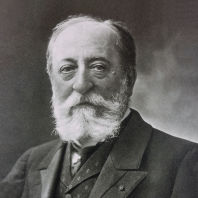Camille Saint-Saëns
Composer
Camille Saint-Saëns’s career path was mapped out at an early stage: at the age of three and a half, he put his first composition to paper, a short piano piece whose autograph was given a precise date by his great-aunt Charlotte Masson: 22 March 1839. At the age of five, Saint-Saëns performed in public for the first time as a pianist, and in May 1846 he could already be heard at the Salle Pleyel, which marked the beginning of a brilliant career as a pianist.
Camille Saint-Saëns, born in Paris on 9 October 1835, was admitted to the conservatoire there in 1848, where he studied piano under Camille Stamaty, organ under François Benoist and composition under Jacques Fromental Halévy. The premiere of his First Symphony three years later was a triumphant success. Hector Berlioz and Charles Gounod admired his music and Richard Wagner considered him – at least for a time – to be the “best musician in his country”. However, the fact that Saint-Saëns championed the music of Bach, Mozart and Beethoven, which was completely under-represented in France, and composed pieces for small ensembles as well as symphonies and instrumental concertos that did not reflect the public taste of that time, soon earned him the reputation of an uncomfortable innovator. While his works met with a positive response in Germany for a long time – Saint-Saëns was a regular guest at orchestral concerts in Berlin, Leipzig and Dresden – the two Franco-German wars meant that he had a difficult time in both countries for political reasons. Nevertheless, his Third Symphony, soon known as the Organ Symphony because of its instrumentation, was a triumph at its London premiere in May 1886 – as was the premiere of Les Barbares at the Paris Opéra in 1901, which marked a high point in Saint-Saëns’s standing in French musical life. The composer and pianist continued to enjoy great popularity on extensive concert tours, which were marked by numerous honours. Saint-Saëns took his leave from the concert stage in Dieppe in August 1921, a few months before his death. He died in Algiers on 16 December 1921 and was given a state funeral and buried at the Cimetière Montparnasse in Paris.